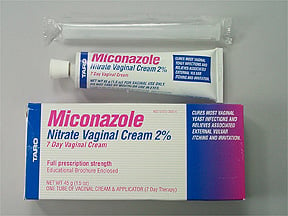
Eq Miconazole 7 Coupons & Savings Card – Discount Prices from $7.31
Brand for: Miconazole nitrate
My prescription
Edit
45GM of 2%, Miconazole Nitrate (1 Box)
Select pharmacy

Walgreens
$7.31
COUPON PRICE
Walmart
$16.22
COUPON PRICE
Albertsons
$18.56
COUPON PRICEEq Miconazole 7 savings card
Show this card to your pharmacist
Walgreens
$7.31
BIN
ID
PCN
GRP
015995
LHEX163480
GDC
GDRX
Powered by
Eq Miconazole 7 (Miconazole Nitrate) dosage forms
Dosage Quantity Price from Per unit 45GM of 2% 1 Box $11.93 $11.93 45GM of 2% 2 Boxes $21.86 $10.93 45GM of 2% 3 Boxes $31.79 $10.60
| Dosage | Quantity | Price from | Per unit |
|---|---|---|---|
| 45GM of 2% | 1 Box | $11.93 | $11.93 |
| 45GM of 2% | 2 Boxes | $21.86 | $10.93 |
| 45GM of 2% | 3 Boxes | $31.79 | $10.60 |
Eq Miconazole 7 Warnings
Eq Miconazole 7 Side Effects
Eq Miconazole 7 Interactions
Miconazole, an antifungal medication, can interact with various other drugs, potentially leading to significant health risks. These interactions primarily occur because miconazole inhibits certain liver enzymes, notably CYP2C9 and CYP3A4, which are responsible for metabolizing many medications. As a result, the levels of these drugs in the bloodstream can increase, heightening the risk of adverse effects.
Anticoagulants (Blood Thinners): When miconazole is used alongside anticoagulants like Warfarin, it can enhance their effects, leading to an increased risk of bleeding. This is due to miconazole's inhibition of CYP2C9, the enzyme that metabolizes warfarin. Patients may experience symptoms such as unusual bruising, nosebleeds, or blood in the urine or stool. It's crucial to monitor blood clotting parameters closely if these medications are used together.
Statins (Cholesterol-Lowering Drugs): Miconazole can also interact with statins, particularly Simvastatin and Atorvastatin, which are metabolized by CYP3A4. Inhibiting this enzyme can lead to higher statin levels in the blood, increasing the risk of muscle-related side effects, including a rare but serious condition called rhabdomyolysis. Patients should be vigilant for unexplained muscle pain or weakness and consult their healthcare provider if such symptoms occur.
Oral Hypoglycemics (Diabetes Medications): For individuals managing diabetes with sulfonylureas like Glipizide or Glyburide, miconazole's inhibition of CYP2C9 can slow the metabolism of these drugs, potentially causing low blood sugar levels (hypoglycemia). Symptoms may include dizziness, sweating, confusion, or even loss of consciousness. Monitoring blood sugar levels more frequently and adjusting medication dosages as needed can help mitigate this risk.
Other Medications: Miconazole may also interact with other drugs metabolized by CYP3A4 and CYP2C9, such as certain antipsychotics, immunosuppressants like Cyclosporine, and some calcium channel blockers. These interactions can lead to increased drug levels and a higher likelihood of side effects. Patients should inform their healthcare providers of all medications they are taking to assess potential interactions.
Recommendations: To minimize the risk of drug interactions, patients should:
Inform Healthcare Providers: Always disclose all medications, including over-the-counter drugs and supplements, to your doctor or pharmacist.
Monitor for Side Effects: Be alert to any unusual symptoms and report them promptly.
Regular Testing: Undergo regular blood tests as recommended to monitor drug levels and organ function.
Alternative Treatments: Discuss with your healthcare provider the possibility of using alternative antifungal treatments that may have a lower risk of interactions.
By being proactive and informed, patients can effectively manage their health while minimizing the risks associated with drug interactions involving miconazole.
What is miconazole 7 used for?
Miconazole 7 is used for the treatment of vaginal yeast infections. It helps relieve symptoms such as itching, burning, and discharge associated with these infections.
Can I use miconazole cream on private parts?
Yes, miconazole cream can be used on the private parts to treat fungal infections such as yeast infections. It is important to follow the instructions provided by a healthcare professional or the product packaging for proper application. If there is any irritation or if symptoms persist, it is advisable to consult a healthcare provider.
What infections does miconazole treat?
Miconazole is used to treat fungal infections, including athlete's foot, jock itch, ringworm, and yeast infections of the skin or vagina.
Is miconazole safe for private parts?
Miconazole is generally considered safe for use on the external genital area to treat fungal infections such as yeast infections. However, it is important to follow the instructions provided with the medication or those given by a healthcare provider. If there is any irritation, discomfort, or if symptoms persist, it is advisable to consult a healthcare professional.
What type of infection is miconazole cream used for?
Miconazole cream is used to treat fungal infections. It is commonly applied for conditions such as athlete's foot, jock itch, ringworm, and yeast infections of the skin.
